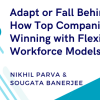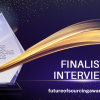1. For the longest time, procurement was measured on cost savings, but now contract management and supplier relationship management are rising priorities. How can organizations drive success in these areas?
The goal of supplier relationship management (SRM) is to establish long-lasting partnerships with strategic suppliers to drive the best possible outcomes for both parties. A key to success is actively reducing friction across your own processes and those of both your strategic and non-strategic suppliers. Driving out inefficiencies will open your capacity to focus on building relationships with the suppliers that matter most to your business. Your strategic suppliers are also freed up to collaborate.
A relentless focus on improving suppliers’ experiences shows you’re a trusted partner. Suppliers who feel valued are more apt to work with you to innovate, reduce risk and pivot in the face of disruptions. Think about where you and your suppliers can leverage automation and intelligence to streamline core processes – such as responding to RFPs, invoice management and collection, onboarding new tools and platforms, payment processing – and make life easier.
Contract management is a great example of an activity that can be significantly streamlined on the buyer side. Companies can have up to 40,000 active contracts at a time. Managing them manually is a costly, time-consuming, and error-prone process. Organizations that lack visibility across their contracts could miss out on negotiated savings or risk maverick spend. Those that leverage technology and artificial intelligence to empower their procurement teams can strategically eliminate these risks, ensure compliance and uncover new value throughout a contract’s lifecycle.
The technology saves teams time and alleviates administrative burdens by centralizing contracts and data. These systems also monitor spending behavior against contracts and quickly flag non-compliant purchases to stop rogue spending. The AI can flag risks, changes in supplier performance, key contract dates, and where improvements to contracts are needed. These systems identify clause variances between third-party contracts and standard legal language across several documents at once, so teams can focus on the contracts that need review. The result is a more efficient and successful procurement operation that is freed up to prioritize managing strategic relationships with suppliers. Contract lifecycle management systems can also integrate with supplier management tools and pull in diversity and sustainability certification data so that teams can confidently choose to do business and build relationships with partners that drive their larger goals.
2. What do you think is the biggest obstacle contributing to the supply chain chaos in 2022 and what can industry professionals do to overcome it?
I‘d say the biggest obstacle is that most teams don’t have the right tools and infrastructure to handle disruptions effectively. Overcoming today’s supply chain chaos requires a fundamentally different approach to how organizations conduct enterprise commerce.
Supply chain teams are dealing with several disruptive forces at once. The shutdowns in China, port congestion, and the shocks caused by the Russia-Ukraine war have exacerbated supply constraints. The conflict has caused massive challenges globally. Europe is facing an energy crisis and scrambling to find alternate energy sources. Africa is dealing with food shortages due to the cut from grain supplies from Ukraine, and the automotive sector still suffers from chip shortages. Most sectors are still in a severe talent crunch. To operate successfully in an environment where volatility and disruptions are the norm, we need to make the supply chain significantly smarter, faster, and more transparent.
Automation and AI play a critical role in this transformation. Predictive intelligence can enable organizations to remain resilient against disruption by helping procurement identify alternate sources and solutions before a situation becomes acute. AI can look across a network of suppliers and recommend those with capabilities that match buyers’ specific needs. Buyers reduce risk and speed up their response time to disruptions by being able to quickly pull the trigger on a new and qualified supply source when they need it. AI can also be deployed to analyze the transactions that flow through a network and prescribe improved and actionable business processes that eliminate bottlenecks, improve cycle times, reduce costs, and resolve issues for procurement teams. Automation can alleviate staffing shortages by autonomously executing tedious and repetitive tasks, which opens up team capacity and empowers procurement professionals to focus on more creative and value-adding activities.
The biggest thing industry professionals can do is to make the case internally for the right tools and resources that put them in a better position to overcome supply chain chaos today and in the future.
3. Buying is different in an inflationary market. How can procurement respond to inflation?
The first step is to understand which categories are most impacted by inflation and the terms of the contracts for those goods and services. Intelligent contract lifecycle management strategies can keep procurement teams aware of the risks within their contracts and flag where and when to negotiate.
Optimize spend in categories where prices aren’t tied to inflation. When negotiating contracts for categories where inflation is a concern, establish limits on the number of price increases a supplier can make. Set clear limits for how much they can increase prices based on how much their own prices rise. SRM is even more critical during periods of high inflation. While you want to keep your own costs low, you don’t want to put your strategic suppliers’ businesses at risk. Build strong relationships with your highest value suppliers and collaborate on innovative ways to reduce costs for both parties and offset future price increases.
Supplier discovery tools, driven by artificial intelligence, offer instant access to information on current and potential suppliers. These tools enable procurement to quickly identify and evaluate new and cost-effective suppliers that meet other key criteria. While costs are rising right now across the board, AI can help quickly identify suppliers that offer a better deal or find partners in lower cost regions that will drive longer-term savings.
Responding to inflation is a cooperative business effort. Procurement needs to be aligned with other departments and understand which price increases can be passed on to customers, which increases need to be absorbed, and where government support is available.
4. How do you think the industry will continue to evolve next year and beyond in terms of new technologies, labor issues and sustainability?
Autonomous Commerce is the future. Similar to the consumer commerce revolution that came before it, buyers, suppliers, and partners will be unified on one platform and leverage automation and AI to streamline how businesses buy and sell goods. The transformation is already happening today and is driving value for procurement teams in several ways. Autonomous Commerce is:
- Networked: Reduces supply chain risk by giving enterprise buyers simplified access to a larger universe of qualified suppliers and automatically matching buyers to the suppliers that meet their specific needs.
- Intelligent: Eases talent shortages by autonomously executing repetitive, behind-the-scenes tasks required to facilitate enterprise commerce.
- Comprehensive: Empowers procurement with end-to-end integration and more agility and time to identify new opportunities for impact, such as tackling environmental, social and corporate governance (ESG) and cybersecurity.
- Extensible: Integrates with other enterprise solutions to enable streamlined workflows and alignment of procurement with broader business objectives.
Companies are at various points in their journey to Autonomous Commerce. The industry will continue to evolve this year and beyond toward fully embracing the Autonomous Commerce vision. This will drive efficiencies, reduce risk, and enable procurement to tackle important issues such as sustainability and talent shortages.
5. What resources and knowledge do industry professionals need to have now that weren’t needed pre-pandemic?
The pandemic accelerated digital transformation, which has made data analysis and other digital skill sets even more important. Many procurement teams are actively hiring data scientists and similar roles to help enable the function to analyze and act on information that is critical to reducing risk.
Soft skills, such as the ability to communicate, collaborate, and build long-term partnerships with suppliers, are now some of the most critical skill sets required of procurement teams. Flexibility and adaptability are also huge. Procurement teams need to be open and ready to pivot to different strategies – supplier diversification, insourcing, and outsourcing – and break the “this is how we’ve always done things” mentality. Similarly, creative problem-solving is now one of the most sought-after skill sets. As procurement professionals lean on technology to streamline routine tasks and free up their time, they can reinvest that time into finding creative ways to better serve their businesses.








